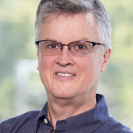
T. Keith Blackwell, M.D., Ph.D.
My laboratory uses the nematode C. elegans to study specific gene regulatory mechanisms that are important for cell development or function. In one major project, we are investigating the functions and regulation of a conserved transcriptional response to oxidative stress. We also study specialized mechanisms that regulate gene expression programs in germ cells, which provide a model for embryonic and other stem cell lineages. We have shown that the transcription factor SKN-1, which initiates embryonic digestive system development, later mobilizes a conserved response to oxidative stress in the intestine. This response appears to be the ancestral function of SKN-1, and may be the most important organismal defense against oxidative stress. We have found that SKN-1 is required for stress resistance and longevity, and can be harnessed to extend lifespan. We are now applying advantages of C. elegans to investigate how SKN-1 and this detoxification pathway are regulated, and have found that SKN-1 is directly targeted by p38, GSK-3, and insulin-like signaling. By uncovering how this stress response functions and is controlled, we expect to identify mechanisms that could be utilized for prevention or treatment of diseases in which oxidative stress plays a central role. We also study mechanisms that regulate gene expression in the germline, a model stem cell population. During germ cell development, many mRNAs are “stored” in particles that we believe are a form of P bodies, a recently described structure in which translationally silenced mRNAs may be stored or degraded. We identified and are studying a group of proteins that regulate the translation and stability of maternal mRNAs in P bodies, and also modulate the frequency at which developing oocytes die by apoptosis. Our studies provide a whole-organism model for studying P bodies, and a window into the little-understood process of developmental germ cell death. In parallel, we are investigating mechanisms that globally silence transcription during late oogenesis and in the early germline. These last studies are important for understanding aspects of germ cell pluripotency and function. As a teacher I have been involved in various Medical and Graduate school courses and teaching activities. During the past year I have tutored in the second year HMS New Pathway Pathology course, after tutoring for many years in this course or Identity, Microbes, and Defense. I have also given the diabetes lecture in a graduate course (Pathology 211, The Molecular Basis of Disease), and have lead a group in the Genetics 330 Proposal Writing course. I have continued to serve on the Preliminary Qualifying Exam Committee of the Harvard Medical School BBS Graduate Program, in which I chair up to 4 exams per year. Until 2004, I served on the Board or Tutors in Biochemical Sciences at Harvard College. As such I advised a small group of undergraduates (2-8), and led them through a non-credit critical reading program. I plan to rejoin the Board of Tutors next year. Finally, in my laboratory I currently supervise seven postdoctoral fellows and share supervision of a graduate student.
PLoS Genet
View full abstract on Pubmed
PLoS Genet
View full abstract on Pubmed
J Am Geriatr Soc
View full abstract on Pubmed
Am J Phys Med Rehabil
View full abstract on Pubmed
Cell
View full abstract on Pubmed
Aging Cell
View full abstract on Pubmed
Sleep
View full abstract on Pubmed
Cell
View full abstract on Pubmed
Arch Neurol
View full abstract on Pubmed